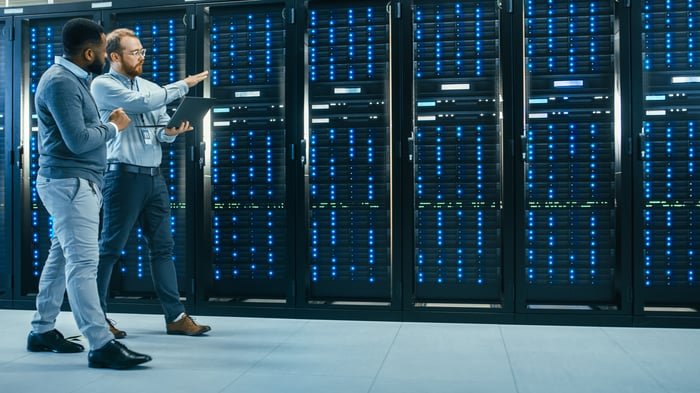AI Insights
How federal tech leaders are rewriting the rules for AI and cyber hiring

Terry Gerton Well, there’s a lot of things happening in your world. Let’s talk about, first, the new memo that came out at the end of August that talks about FedRAMP 20x. Put that in plain language for folks and then tell us what it means for PSC and its stakeholders.
Jim Carroll Yeah, I think really what it means, it’s a reflection of what’s happening in the industry overall, the GovCon world, as well as probably everything that we do, you know, even as individual citizens, which is more and more reliance on AI. What we’re seeing is the artificial intelligence world has really picked up steam, not only I saw mention of it on the news today and they were talking about — every Google search now incorporates AI. So what we’re seeing with this GSA and FedRAMP initiative is really trying to fast track the authorization of the cloud-based services side of AI. Because it really is becoming more and more part of every basic use, not only in our private lives, like they talk about, but also in the federal contracting space. And what we are seeing are more and more federal government officials using it for routine things. And so I think what this is is really a reflection that they are going to move this as quickly as possible, in recognition that the world is changing right in front of us.
Terry Gerton So is this more for government contractors who are offering AI products, or for government contractors who are using AI in their internal products?
Jim Carroll It’s really for AI-based cloud services who are able to use AI tools that not only allow them, but really allow federal workers to be able to access AI in a much faster space. And, you know, there’s certainly some challenges with AI. I think, you’re hearing some of the futurists talk about, do we really understand AI enough to embrace it to the extent that we have? I don’t think anyone really knows the answer to that, but we know it’s out there and there is this recognition that there will be an ongoing routine federal use of AI. So let’s at least have the major players that are doing it the best authorized to be able to provide the service. And so much is happening right now in the AI space. And I think everyone knows the acronym. There’s a lot of acronyms we’re going to talk about today that are happening, but AI is an acronym that really is. And we did a poll and looked at our 400 member companies at PS Council. And I think it was 45% or 50% mentioned the use of AI on their homepage. And so I think there’s just recognition that GSA wants to be able to provide these solutions to the federal government workers.
Terry Gerton Do you see any risks or trade-offs in accelerating this approval versus adopting things that might not quite be ready for prime time?
Jim Carroll You know, I think there’s always that concern, as I mentioned, about some of the futurists that are looking at this and making sure that it’s safe. We’re hearing about it from the White House and we’re putting together — you’ve seen some public panels already with the White House, we’ve been asked to bring our PSC members for a policy discussion and some of the legal issues around AI to the White House. And so we’ll be bringing some members to the White House here in the next couple of weeks. And so I think there is concern that the people who use AI are also double-checking to make sure it’s accurate, right? That’s one of the concerns I think that people want to make sure is that there should not be an over-reliance or an exclusive reliance on AI tools. And we need to make sure that the solutions and the answers that our AI tools are giving us are actually accurate. One of the concerns, which I think goes into something we need to discuss that’s happening this week, is cybersecurity. Is AI secure? Is the use of it going to be able to safeguard some of the really important national security work that we’re doing? And how do we do that?
Terry Gerton I’m speaking with Jim Carroll. He’s the CEO of the Professional Services Council. Well, let’s stick in that tech vein and cybersecurity. There’s a new bill in Congress that wants to shift cybersecurity hiring to more of a skills-based qualification than professional degrees. How does PSC think about that proposal?
Jim Carroll I think again, it’s a reflection of what’s actually out there — that these new tools, we’ll say in cybersecurity, [are] really based on an individual’s ability to maneuver in this space, as opposed to just a degree. And being able to really focus on the ability of everyone, I think equals the playing field, right? It means more and more people are qualified to do this. When you take away a — I hate to say a barrier such as a degree, but it’s a reflection that there are other skill sets that people have learned to be able to actually do their work. And I can say this, having gotten a law degree many years ago, that you really sort of learn how to practice law by doing it and by having a mentor and doing it over the years, as opposed to just having a law degree. I don’t think it would be a good person to just go out and represent anyone on anything on the day after graduating from law school. You really need to learn how to apply it and I think that’s what this bipartisan bill is doing. And so you know, we’re encouraging more and more people being able to get into this, because there’s a greater and greater need, Terry. And so we’re okay with this.
Terry Gerton So what might it mean then for the GovCon workforce?
Jim Carroll I think there’s an opportunity here for the GovCon workspace and employees to be able to expand and really get some super-talented people to be able to work at these federal agencies. Which is a great plus, I think, for actually achieving the desired results that our GovCon members at PS Council are able to deliver, is we’re going to get the best and brightest and bring those people in to give real solutions.
Terry Gerton So the bill calls for more transparency from OPM on education-related hiring policies. Does PSC have an idea of what kind of oversight they’d like to see about that practice?
Jim Carroll Yeah, we’re looking into it now. We’re talking to our members and seeing what kind of oversight they have. You know, representing 400 organizations, companies that do business with the federal government and so many in this space of cybersecurity, being the leading trade organization for these 400 companies, it means that we’re able to go to our members and get from them, really, the safeguards that they think are important. Get the requirements that they think are important and get it in there. And so this is going to be a deliberative process. We have a little bit of time to work on this. But we’re excited about the potential. We really think this will be able to deliver great solutions, Terry.
Terry Gerton Well, speaking of cyber, there’s a new memo out on the cybersecurity maturity model. What’s your hot take there?
Jim Carroll Terry, how long has that been pending? I think five years. I think it’s five years is what I heard this morning. And so, you know, this will provide three levels of certification and clarity for CMMC [(Cybersecurity Maturity Model Certification)]. We’re looking at it now. This is obviously a critical issue and we are starting a working group. And we’re going to be able to provide resources to our members for this, to make sure that the certification — some of which are going to be very expensive for our members, depending on what type of certification that they want. So we’re gearing up. We have been ready for this. Like I said, we started planning this for five years ago, right? So did you, Terry. And so we have five years of thought going into it and we will be announcing and developing a website for our members to be able to have information on this, learn from this. We’ll be conducting seminars for our members. So now that CMMC — the other acronym I think that I mentioned earlier — is finally here, it’ll be implemented, I guess, in 60 days. And so we’ll have some time to use the skills that we have been developing over the last five years to give to our members.
Terry Gerton Any surprises for you in the final version? I know that PSC had quite a bit of input in the development.
Jim Carroll Not right now. We’re sort of looking at it; obviously, it just dropped in the last 24 hours. And so nothing right now that has caught us off guard. And so we’ve been ready for this and we’re ready to educate our members on this.
Copyright
© 2025 Federal News Network. All rights reserved. This website is not intended for users located within the European Economic Area.
AI Insights
China’s Open-Source Models Are Testing US AI Dominance

While the AI boom seemingly began in Silicon Valley with OpenAI’s ChatGPT three years ago, 2025 has been proof that China is highly competitive in the artificial intelligence field — if not the frontrunner. The Eastern superpower is building its own open-source AI programs that have demonstrated high performance as they put ubiquity and effectiveness over profitability (while still managing to make quite a bit of money), the Wall Street Journal reports.
DeepSeek is probably the most well-known Chinese AI entity in the U.S., whose R1 reasoning model became popular at the start of the year. Being open-source, as opposed to proprietary, means these programs are free and their source code can be downloaded, used and tinkered with by anyone. Qwen, Moonshot, Z.ai and MiniMax are other such programs.
This is in contrast to U.S. offerings like ChatGPT, which, though free to use (up to a certain level of compute), are not made available to be modified or extracted by users. (OpenAI did debut its first open-source model, GPT-OSS, last month.)
American companies like OpenAI are racing to catch up — monopolies and industry-standard technologies are often the ones that are the most accessible and customizable. The Trump administration wagered that open-source models “could become global standards in some areas of business and in academic research” in July.
Want to join the conversation on how the security of information and data is impacting our global power struggle with China? Attend the 2025 Intel Summit on Oct. 2, from Potomac Officers Club. This GovCon-focused event will include a must-attend panel discussion called “Guarding Innovation: Safeguarding Research and IP in the Era of Strategic Competition With China.” Register today!
China’s Tech Progress Has Big Implications
The Intel Summit panel will feature, among other distinguished guests, David Shedd, a highly experienced intel community official who was acting director of the Defense Intelligence Agency (after serving as its deputy director for four years) and deputy director of national intelligence for policy, plans and procedures.
Shedd spoke to GovCon Wire in an exclusive interview about China-U.S. competition ahead of his appearance on the panel. He said that China’s progress in areas like AI should not be taken lightly and could portend greater problems and tension in the future.
“Sensitive IP or technological breakthroughs in things like AI, stealth fighter jets, or chemical formulas lost to an adversary do not happen in a vacuum. They lead, instead, to the very direct and very serious loss of the relative capabilities that define and underpin the balance and symbiosis of relationships within the international system,” Shedd commented.
Open-source models are attractive to organizations, WSJ said, because they can customize the programs and use them internally and protect sensitive data. In their Intel Summit panel session, Shedd and his counterparts will explore how the U.S. might embrace open-source more firmly as a way to stay agile in the realm of research and IP protection.
Who Is Stronger, America or China?

Shedd, along with co-author Andrew Badger, is publishing a book on December 2 entitled “The Great Heist: China’s Epic Campaign to Steal America’s Secrets.” Published through HarperCollins, the volume will focus on the campaign of intellectual property theft the Chinese government is waging against the U.S.
Shedd elaborated for us:
“The PRC/CCP’s unrelenting pursuit of stolen information from the West and the U.S. in particular has propelled China’s economic and military might to heights previously unimaginable. Yet we collectively continue to underestimate the scale of this threat. It’s time for the world to fully comprehend the depth and breadth of China’s predatory behavior.
Our national security depends on how we respond—and whether we finally wake up to the reality that China has already declared an economic war on the West using espionage at the forefront of its campaign. It already has a decades-long head start.”

Don’t miss former DIA Acting Director David Shedd, as well as current IC leaders like Deputy Director of National Intelligence Aaron Lukas and CIA’s AI office Deputy Director Israel Soong at the 2025 Intel Summit on Oct. 2! Save your spot before it’s too late.
AI Insights
Move Over Palantir. This Artificial Intelligence (AI) Stock Just Took Over as the S&P 500’s Best Performer in 2025.

This AI-driven megatrend has sent this stock and its closest competitor rocketing higher in 2025.
Many artificial intelligence (AI) stocks have zoomed higher over the last three years, following the introduction of OpenAI’s ChatGPT. One of the biggest winners, by far, has been Palantir Technologies (PLTR 2.70%). The enterprise software company integrated generative AI into its software in 2023, and it’s seen sales and profits soar ever since. The stock is up a cumulative 2,500% since the start of 2023, including a 120.7% rise in 2025 alone, as of this writing.
Up until last week, that was good enough to make it the best performer in the S&P 500 at the moment. But another stock overtook the market darling’s year-to-date performance at the start of September, boosted by the voracious demand for artificial intelligence. Say hello to the new best-performing stock in the S&P 500.
Image source: Getty Images.
Essential infrastructure for AI data centers
Big tech companies are spending hundreds of billions of dollars on building out data centers and outfitting them with servers. Chipmakers like Nvidia have benefited greatly as demand for graphics processing units (GPUs) and custom AI accelerators continues to climb. But there’s another important component to building out data centers: Storage.
AI training is extremely data-intensive. While some of that data needs to be readily accessible quickly, a lot of it can be held in what’s called “nearline” storage. Nearline storage might take a few seconds to access, but it’s a cheap and effective way to maintain the huge amounts of data needed for large language models.
Hard drive maker Seagate Technology (STX 0.76%) has seen demand for nearline storage explode, helping push its stock to a 121.4% gain so far this year, as of this writing. That’s better than every other stock in the S&P 500, including Palantir.
The company shipped 137 exabytes of capacity to data center customers last quarter, up 14% sequentially and 52% year over year. The financial results are just as impressive. Revenue grew 39% in fiscal 2025. Gross profit margin expanded to 35.2% from 23.4% last year. Fourth-quarter gross margin was even more impressive at 37.4%, as the market remains supply-constrained.
Seagate is one of two major suppliers of hard drives. Western Digital (WDC 0.51%) remains its biggest rival, maintaining a nearly equal share of the market. Unsurprisingly, Western Digital is also a top-performing stock this year, as it benefits from the exact same mega trend as Seagate. While both have made strides in increasing storage capacity per unit, there’s still a limit to how much each can produce. Thus, they’ve both seen strong gross margin expansion.
Tech companies are planning to keep spending on new data centers and the necessary increased storage capacity that comes along with them. Seagate’s management expects data center storage demand to climb from $13 billion in 2024 to $23 billion by 2028. Western Digital shared a similar outlook at its investor day in February. As a result, the current cycle of growth could extend for years to come.
Is it worth the price?
Hard drives are kind of a commodity for data centers. A buyer could use any supplier, and the hard drives will fit into the same exact spot in their data center as any other hard drive would. The only major difference is how much storage capacity each drive has, which makes price per terabyte (TB) the biggest deciding factor for a buyer.
As a result, competition between Seagate and Western Digital has typically kept pricing low and pushed new technology forward relatively quickly. Margin expansion only really happens when there’s a huge demand cycle like we’re currently seeing. When the cycle ends, and it will, both companies will see deterioration in their margins until the next uptick in demand.
Seagate seems to have developed a slight technology lead. Its heat-assisted magnetic recording (HAMR) process is on track to be able to scale production of 40TB hard drives by the second half of fiscal 2026 (early calendar 2026). Western Digital isn’t on track to start mass production of 40TB hard drives — it’s about six months behind. That could open the door for Seagate to take some market share over the next few years and grow slightly faster than its chief rival.
At a forward price-to-earnings (P/E) ratio of 18.5, investors may think Seagate is an absolute bargain compared to most AI stocks. When you compare it with Palantir’s eye-popping 245 times earnings multiple, it seems extremely cheap. But it’s important to put that in context.
While Seagate is growing earnings extremely quickly right now, it’s still in a cyclical industry. Cyclical stocks tend to trade at much more attractive earnings multiples amid upcycles in demand. That’s because they could see a massive drop in earnings power if demand dries up, or even if supply growth starts to outpace demand.
For a point of reference, Western Digital trades for a forward P/E ratio close to 14. While Seagate may deserve a slight premium to Western Digital, both are trading at a premium to their historic pricing over the past year after their recent run to put them at the top of the S&P 500’s best-performers list. At this point, it might be worth waiting for a better price on both stocks before buying into the latest big winner from artificial intelligence spending.
Adam Levy has no position in any of the stocks mentioned. The Motley Fool has positions in and recommends Nvidia and Palantir Technologies. The Motley Fool has a disclosure policy.
AI Insights
This $1 Trillion Artificial Intelligence (AI) Stock Will Be the Next Nvidia

Key Points
-
Broadcom has outperformed Nvidia over the past year, and that trend appears poised to continue.
-
The company’s prosperous artificial intelligence (AI) semiconductor and data center business is taking market share from the leader, according to Wall Street.
-
Broadcom made a surprise announcement during its recent quarterly results that caught investors off guard.
-
10 stocks we like better than Nvidia ›
Since the dawn of the artificial intelligence (AI) era, a number of players have been at the leading edge of the technology. Perhaps no company has exemplified the vast potential of AI more than Nvidia (NASDAQ: NVDA). Since early 2023, the chipmaker’s stock has surged more than 1,000% (as of this writing) as its graphics processing units (GPUs) have become the gold standard for facilitating the technology.
However, investors may be surprised to learn that Broadcom (NASDAQ: AVGO) has actually outperformed Nvidia over the past year, as its stock has soared 149% compared with 63% for Nvidia. Furthermore, several pronouncements by the company during its recent quarterly report suggest that trend is poised to continue.
Where to invest $1,000 right now? Our analyst team just revealed what they believe are the 10 best stocks to buy right now. Continue »
Let’s look at what’s driving Broadcom’s robust rally and why I predict the company is on track to be the next Nvidia.
Image source: Getty Images.
The next big winner
Nvidia’s GPUs have transformed AI by providing the massive computational horsepower required to power AI models. These lightning-fast chips offer extremely flexible use cases and are unmatched for this purpose, which is why Nvidia has thrived over the past few years.
It’s also no surprise that Broadcom has benefited from the accelerating adoption of AI, as the company’s Ethernet switching and networking products have long been a staple in data centers. However, Broadcom’s application-specific integrated circuits (ASICs) have been gaining ground. These custom-designed AI accelerators, which Broadcom calls XPUs, are tailored to specific tasks and therefore more energy efficient. Rapid adoption of this chips has fueled a blistering run for Broadcom stock, which is up more than 500% since early 2023, earning its membership in the $1 trillion club.
In the third quarter, Broadcom generated record revenue that accelerated 22% year over year to $15.9 billion, resulting in adjusted earnings per share (EPS) that jumped 36% to $1.69. The company was clear that it was AI that was driving this train, as its AI-specific revenue accelerated 63% year over year to $5.2 billion. The results were well ahead of Wall Street’s expectations, as analysts’ consensus estimates called for revenue of $15.82 billion and adjusted EPS of $1.66.
For context, in its fiscal 2026 second quarter (ended July 27), Nvidia’s data center segment, driven primarily by AI, grew 56% year over year, down from 73% growth in Q1, which shows its growth is decelerating.
However, it was management’s commentary that gave investors cause to celebrate, as Broadcom delivered two pieces of news that bode well for the future.
First, Broadcom stated that it continues to expand its business with its three biggest hyperscale customers. While the company doesn’t disclose who these customers are, they are widely believed to be Alphabet, Meta Platforms, and TikTok parent ByteDance. During the conference call to discuss the results, CEO Hock Tam said, “We continue to gain share at our three original customers.” He went on to say the company is forecasting its AI-centric growth to be higher next year, accelerating compared to the 50% to 60% growth it expects in 2025.
The other big development was that Broadcom confirmed the addition of a fourth big hyperscale customer, which many analysts believe to be OpenAI. The company said this new client moved from prospect to “qualified customer,” and had approved production of “AI racks based on our XPUs.” As a result, Broadcom boosted its backlog by $10 billion to $110 billion.
The next Nvidia?
Wall Street’s reaction to Broadcom’s results was decidedly bullish, as no fewer than 16 analysts boosted their price targets on the stock. Many of these cited the accelerating demand for Broadcom’s ASICs as a factor.
Ben Reitzes of Melius Research views Broadcom as a “Magnificent Eight” stock, arguing that it should be added to the Magnificent 7 stocks. He goes on to say that he has long believed that Nvidia’s share would fall over time, with Broadcom eventually taking a roughly 30% share of the AI compute market.
That said, Reitzes also believes that a rising tide lifts all boats, and both companies will be massive winners as the adoption of AI continues to gain steam. That said, the analyst points out that over the long term, Nvidia’s CUDA programming library shouldn’t be underestimated, as this software ecosystem is favored by developers and provides Nvidia with a significant competitive advantage.
So while Broadcom will likely be the next Nvidia, the demand for AI continues to climb, and the market will be able to support two major players, so Nvidia and Broadcom will likely both be market-beating investments from here.
From a valuation perspective, the recent spike in Broadcom’s stock price has seen a commensurate increase in its multiple. Broadcom stock is currently selling for 37 times next year’s earnings, compared to 27 for Nvidia. Both are trading for a premium, but both are also well-positioned to profit from the growing adoption of AI.
Should you invest $1,000 in Nvidia right now?
Before you buy stock in Nvidia, consider this:
The Motley Fool Stock Advisor analyst team just identified what they believe are the 10 best stocks for investors to buy now… and Nvidia wasn’t one of them. The 10 stocks that made the cut could produce monster returns in the coming years.
Consider when Netflix made this list on December 17, 2004… if you invested $1,000 at the time of our recommendation, you’d have $681,260!* Or when Nvidia made this list on April 15, 2005… if you invested $1,000 at the time of our recommendation, you’d have $1,046,676!*
Now, it’s worth noting Stock Advisor’s total average return is 1,066% — a market-crushing outperformance compared to 186% for the S&P 500. Don’t miss out on the latest top 10 list, available when you join Stock Advisor.
See the 10 stocks »
*Stock Advisor returns as of September 8, 2025
Danny Vena has positions in Alphabet, Broadcom, Meta Platforms, and Nvidia. The Motley Fool has positions in and recommends Alphabet, Meta Platforms, and Nvidia. The Motley Fool recommends Broadcom. The Motley Fool has a disclosure policy.
Disclaimer: For information purposes only. Past performance is not indicative of future results.
-

 Business2 weeks ago
Business2 weeks agoThe Guardian view on Trump and the Fed: independence is no substitute for accountability | Editorial
-
Tools & Platforms1 month ago
Building Trust in Military AI Starts with Opening the Black Box – War on the Rocks
-

 Ethics & Policy2 months ago
Ethics & Policy2 months agoSDAIA Supports Saudi Arabia’s Leadership in Shaping Global AI Ethics, Policy, and Research – وكالة الأنباء السعودية
-

 Events & Conferences4 months ago
Events & Conferences4 months agoJourney to 1000 models: Scaling Instagram’s recommendation system
-

 Jobs & Careers2 months ago
Jobs & Careers2 months agoMumbai-based Perplexity Alternative Has 60k+ Users Without Funding
-

 Podcasts & Talks2 months ago
Podcasts & Talks2 months agoHappy 4th of July! 🎆 Made with Veo 3 in Gemini
-

 Education2 months ago
Education2 months agoVEX Robotics launches AI-powered classroom robotics system
-

 Education2 months ago
Education2 months agoMacron says UK and France have duty to tackle illegal migration ‘with humanity, solidarity and firmness’ – UK politics live | Politics
-

 Funding & Business2 months ago
Funding & Business2 months agoKayak and Expedia race to build AI travel agents that turn social posts into itineraries
-

 Podcasts & Talks2 months ago
Podcasts & Talks2 months agoOpenAI 🤝 @teamganassi












